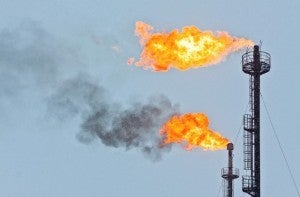By Daniel Roda-Stuart, Fellow

With oil and natural gas production, it’s not only the industry that benefits monetarily. Mineral rights holders (the people who actually own the oil and gas deep below the earth’s surface) benefit too. Depending on where you look in the United States, who owns these mineral rights varies. In many places those minerals are owned by individuals and in other situations it’s the federal or state government.
In the Western U.S., it can often be Native American tribes that own the rights to these resources. And the revenue from the production of these tribal resources can be invaluable for funding education, health care, and other programs. So, what happens when faulty equipment and poor practices allow valuable natural gas to escape to the atmosphere before making it to the sales line? It can result in millions of dollars of lost royalty revenue for Native American tribes.
A recent EDF analysis focuses on the value of this wasted gas and the financial impacts to the Northern Ute tribe in the Uintah Basin of Northeastern Utah.
| Mineral Rights | Surface Location | |||
| Lower | Upper | Lower | Upper | |
| Tribal Base Emissions [mcf NG/yr] | 1,242,531 | 1,380,590 | 3,141,158 | 3,490,176 |
| Tribal Flaring/Venting [mcf NG/yr] | 169,897 | 188,775 | 376,513 | 418,347 |
| Tribal Liquids Unloading [mcf NG/yr] | 29,791 | 33,101 | 240,613 | 267,348 |
| Total Tribal Waste [mcf NG/yr] | 1,442,219 | 1,602,466 | 3,758,284 | 4,175,871 |
| Value of Wasted Gas at 2.85 $/mcf [$/yr] | $4,110,325 | $ 4,567,028 | $10,711,108 | $11,901,232 |
| Value of Lost Royalty at 18% [$/yr] | $739,859 | $822,065 | $1,928,000 | $2,142,222 |
| Value of Lost Royalty at 20% [$/yr] | $822,065 | $913,406 | $ 2,142,222 | $2,380,246 |
Natural gas is considered wasted if it could have been captured, yet was either intentionally or unintentionally released to the atmosphere via flaring, leaks or venting. Accidental leaks, equipment operation and malfunctions, and routine flaring and venting are all significant sources of wasted gas. The analysis found that on Northern Ute reservation land, the value of wasted gas was up to $12 million per year. This translates to lost royalties to the tribe of between $750,000 to $1 million per year. And to put this in a different perspective, this lost gas would have been enough to meet the needs of 60,000 Utah households (or over 80% of the households in Salt Lake City) for a year.
This wasted gas not only has a monetary value, but has significant climate and health impacts as well. Methane is the primary constituent of natural gas and has a greater near term global warming potential than carbon dioxide. Volatile organic compounds found in natural gas also contribute to the formation of ozone pollution, which has significant impacts on local air quality and is leading to unhealthy air in the area. In fact, the Uintah Basin t is out of compliance with federal, health-based ozone standards. A 2012 study showed that reduced concentrations of ozone in the United States would result in thousands of avoided ozone-related premature deaths each year. Improved oil and gas operations in the basin would result in lower concentrations of ozone and better air quality.
However, the good news is that cost effective avenues exist to ensure that the Northern Ute tribe receives its fair share of royalties, and that those who live in the basin have access to the clean air they deserve.
New rules currently being finalized by the Bureau of Land Management aim to reduce methane emissions from oil and gas production on tribal lands, and will reduce the amount of wasted gas to ensure royalty-holders receive their fair share. Forthcoming actions from the Environmental Protection Agency (EPA) including a Federal Implementation Plan to improve air quality on tribal lands should also mean healthier air for local communities if they adequately target pollution from oil and gas operations.
Strong measures like these are needed to guarantee that concrete improvements to air quality and resource management come to fruition. Policies from federal, state and tribal regulators that target methane emissions will protect the rights and interests of too often-overlooked tribes, fight the long-term impacts of climate change, and protect the health and well-being of local communities.









